Health Care in Australia: Principles, Issues, and Case Study Analysis
VerifiedAdded on 2022/11/25
|8
|1598
|362
Report
AI Summary
This report provides a comprehensive analysis of health care in Australia, addressing key principles of primary health care such as accessibility, community participation, health promotion, and appropriate use of technology. It examines environmental impacts like air and water quality, and ultraviolet radiation, discussing their effects on health. The report outlines the philosophical framework of primary healthcare including wellness, incidence and pathology, learning programs, and available resources. It presents a case study involving a patient experiencing a health crisis, detailing immediate actions, evidence-based practices, and sources of primary healthcare literature. The report also explores the role of nurses in healthcare, the health issues of indigenous Australians, and barriers to health literacy. It concludes with recommendations for promoting patient health and addressing communication challenges. The assignment is a detailed overview of the Australian healthcare system, providing insights into various aspects of healthcare delivery and patient care.
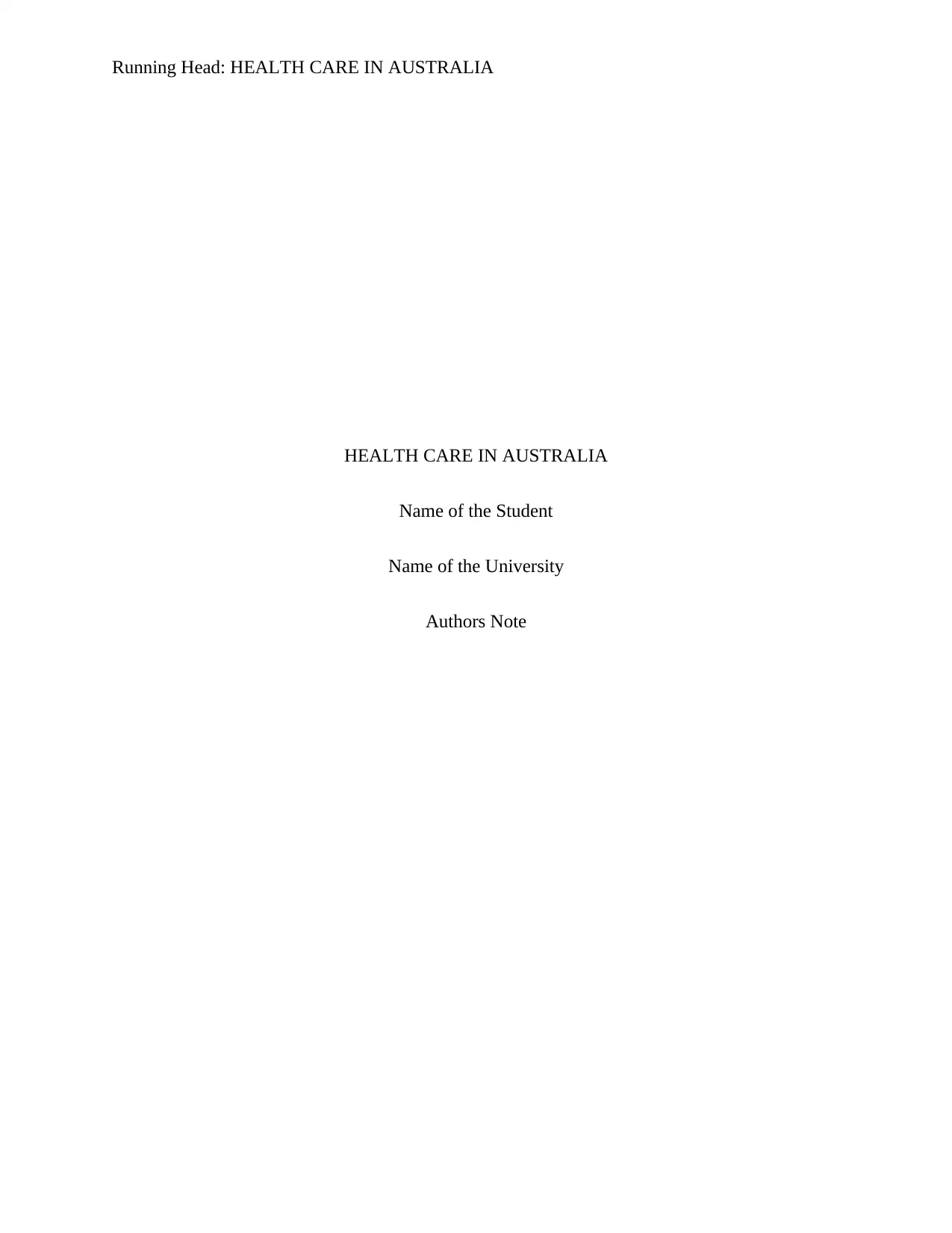
Running Head: HEALTH CARE IN AUSTRALIA
HEALTH CARE IN AUSTRALIA
Name of the Student
Name of the University
Authors Note
HEALTH CARE IN AUSTRALIA
Name of the Student
Name of the University
Authors Note
Paraphrase This Document
Need a fresh take? Get an instant paraphrase of this document with our AI Paraphraser
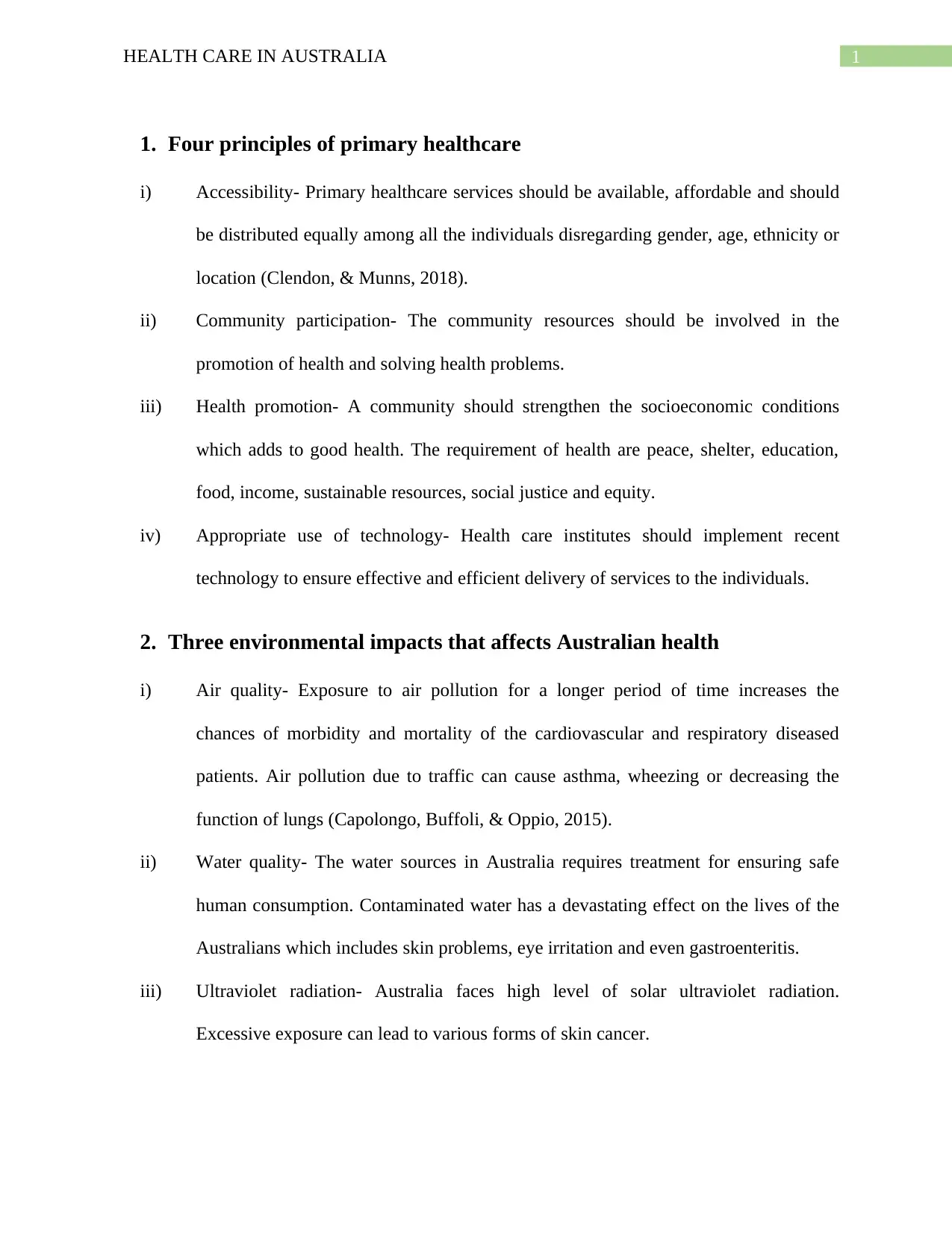
1HEALTH CARE IN AUSTRALIA
1. Four principles of primary healthcare
i) Accessibility- Primary healthcare services should be available, affordable and should
be distributed equally among all the individuals disregarding gender, age, ethnicity or
location (Clendon, & Munns, 2018).
ii) Community participation- The community resources should be involved in the
promotion of health and solving health problems.
iii) Health promotion- A community should strengthen the socioeconomic conditions
which adds to good health. The requirement of health are peace, shelter, education,
food, income, sustainable resources, social justice and equity.
iv) Appropriate use of technology- Health care institutes should implement recent
technology to ensure effective and efficient delivery of services to the individuals.
2. Three environmental impacts that affects Australian health
i) Air quality- Exposure to air pollution for a longer period of time increases the
chances of morbidity and mortality of the cardiovascular and respiratory diseased
patients. Air pollution due to traffic can cause asthma, wheezing or decreasing the
function of lungs (Capolongo, Buffoli, & Oppio, 2015).
ii) Water quality- The water sources in Australia requires treatment for ensuring safe
human consumption. Contaminated water has a devastating effect on the lives of the
Australians which includes skin problems, eye irritation and even gastroenteritis.
iii) Ultraviolet radiation- Australia faces high level of solar ultraviolet radiation.
Excessive exposure can lead to various forms of skin cancer.
1. Four principles of primary healthcare
i) Accessibility- Primary healthcare services should be available, affordable and should
be distributed equally among all the individuals disregarding gender, age, ethnicity or
location (Clendon, & Munns, 2018).
ii) Community participation- The community resources should be involved in the
promotion of health and solving health problems.
iii) Health promotion- A community should strengthen the socioeconomic conditions
which adds to good health. The requirement of health are peace, shelter, education,
food, income, sustainable resources, social justice and equity.
iv) Appropriate use of technology- Health care institutes should implement recent
technology to ensure effective and efficient delivery of services to the individuals.
2. Three environmental impacts that affects Australian health
i) Air quality- Exposure to air pollution for a longer period of time increases the
chances of morbidity and mortality of the cardiovascular and respiratory diseased
patients. Air pollution due to traffic can cause asthma, wheezing or decreasing the
function of lungs (Capolongo, Buffoli, & Oppio, 2015).
ii) Water quality- The water sources in Australia requires treatment for ensuring safe
human consumption. Contaminated water has a devastating effect on the lives of the
Australians which includes skin problems, eye irritation and even gastroenteritis.
iii) Ultraviolet radiation- Australia faces high level of solar ultraviolet radiation.
Excessive exposure can lead to various forms of skin cancer.
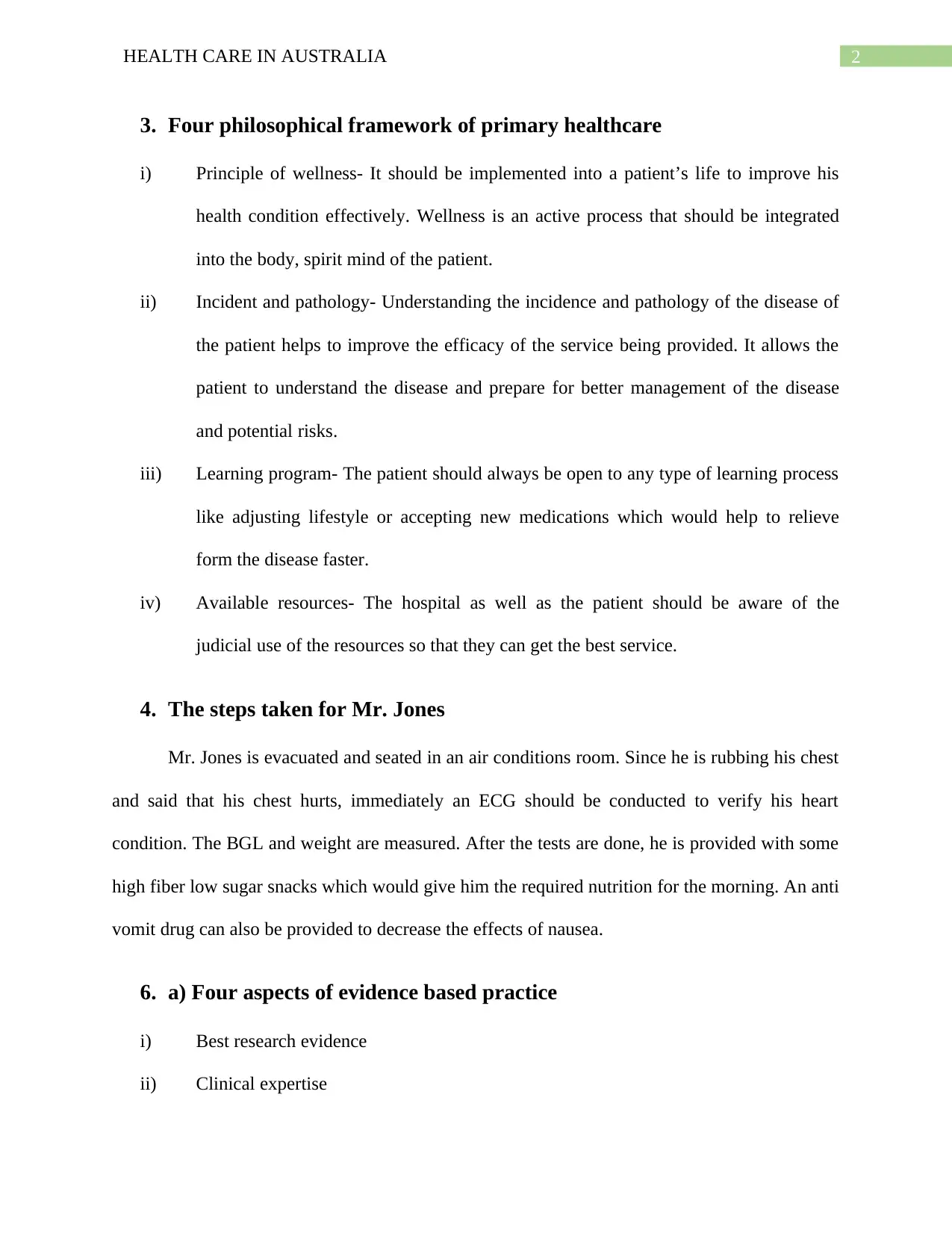
2HEALTH CARE IN AUSTRALIA
3. Four philosophical framework of primary healthcare
i) Principle of wellness- It should be implemented into a patient’s life to improve his
health condition effectively. Wellness is an active process that should be integrated
into the body, spirit mind of the patient.
ii) Incident and pathology- Understanding the incidence and pathology of the disease of
the patient helps to improve the efficacy of the service being provided. It allows the
patient to understand the disease and prepare for better management of the disease
and potential risks.
iii) Learning program- The patient should always be open to any type of learning process
like adjusting lifestyle or accepting new medications which would help to relieve
form the disease faster.
iv) Available resources- The hospital as well as the patient should be aware of the
judicial use of the resources so that they can get the best service.
4. The steps taken for Mr. Jones
Mr. Jones is evacuated and seated in an air conditions room. Since he is rubbing his chest
and said that his chest hurts, immediately an ECG should be conducted to verify his heart
condition. The BGL and weight are measured. After the tests are done, he is provided with some
high fiber low sugar snacks which would give him the required nutrition for the morning. An anti
vomit drug can also be provided to decrease the effects of nausea.
6. a) Four aspects of evidence based practice
i) Best research evidence
ii) Clinical expertise
3. Four philosophical framework of primary healthcare
i) Principle of wellness- It should be implemented into a patient’s life to improve his
health condition effectively. Wellness is an active process that should be integrated
into the body, spirit mind of the patient.
ii) Incident and pathology- Understanding the incidence and pathology of the disease of
the patient helps to improve the efficacy of the service being provided. It allows the
patient to understand the disease and prepare for better management of the disease
and potential risks.
iii) Learning program- The patient should always be open to any type of learning process
like adjusting lifestyle or accepting new medications which would help to relieve
form the disease faster.
iv) Available resources- The hospital as well as the patient should be aware of the
judicial use of the resources so that they can get the best service.
4. The steps taken for Mr. Jones
Mr. Jones is evacuated and seated in an air conditions room. Since he is rubbing his chest
and said that his chest hurts, immediately an ECG should be conducted to verify his heart
condition. The BGL and weight are measured. After the tests are done, he is provided with some
high fiber low sugar snacks which would give him the required nutrition for the morning. An anti
vomit drug can also be provided to decrease the effects of nausea.
6. a) Four aspects of evidence based practice
i) Best research evidence
ii) Clinical expertise
⊘ This is a preview!⊘
Do you want full access?
Subscribe today to unlock all pages.

Trusted by 1+ million students worldwide
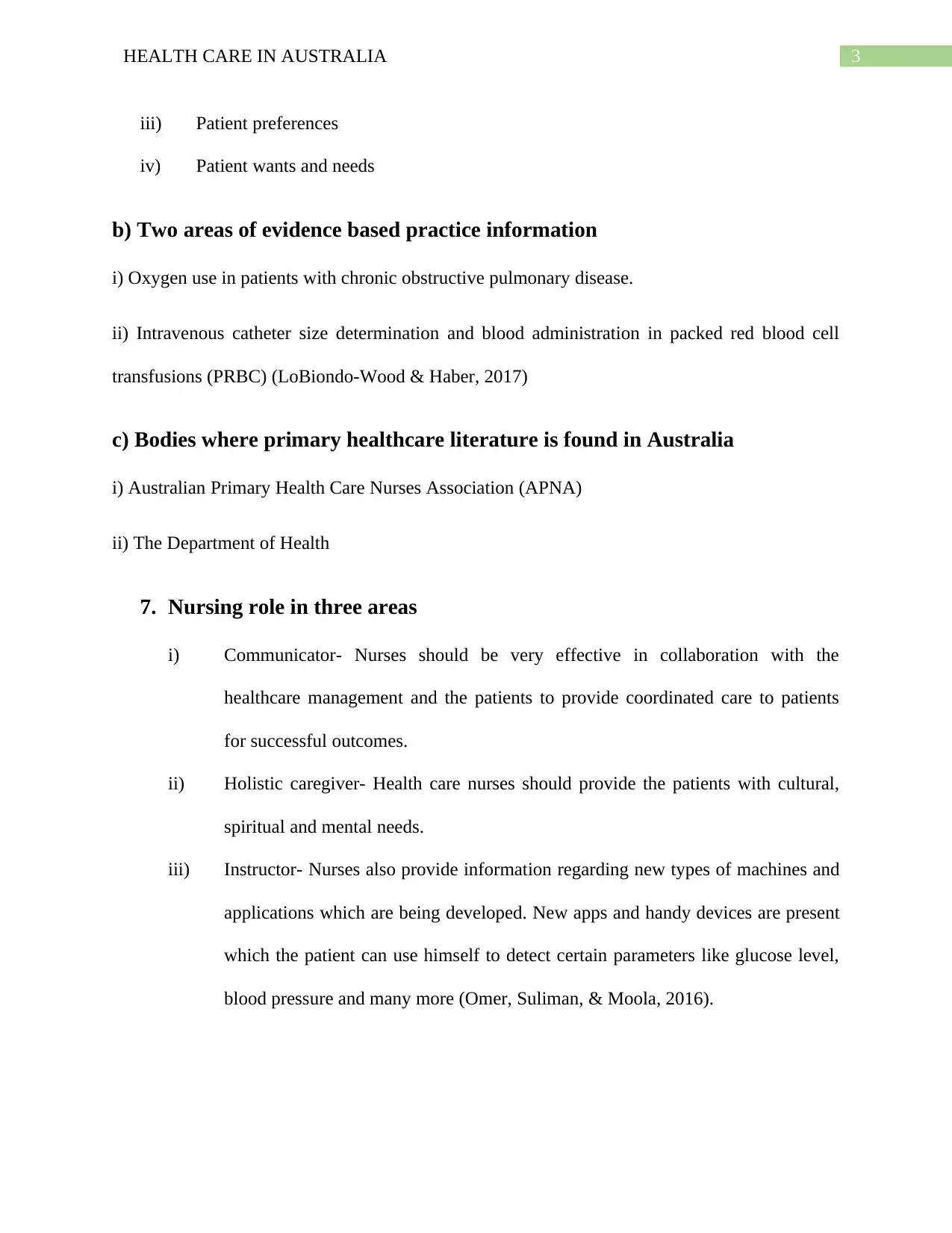
3HEALTH CARE IN AUSTRALIA
iii) Patient preferences
iv) Patient wants and needs
b) Two areas of evidence based practice information
i) Oxygen use in patients with chronic obstructive pulmonary disease.
ii) Intravenous catheter size determination and blood administration in packed red blood cell
transfusions (PRBC) (LoBiondo-Wood & Haber, 2017)
c) Bodies where primary healthcare literature is found in Australia
i) Australian Primary Health Care Nurses Association (APNA)
ii) The Department of Health
7. Nursing role in three areas
i) Communicator- Nurses should be very effective in collaboration with the
healthcare management and the patients to provide coordinated care to patients
for successful outcomes.
ii) Holistic caregiver- Health care nurses should provide the patients with cultural,
spiritual and mental needs.
iii) Instructor- Nurses also provide information regarding new types of machines and
applications which are being developed. New apps and handy devices are present
which the patient can use himself to detect certain parameters like glucose level,
blood pressure and many more (Omer, Suliman, & Moola, 2016).
iii) Patient preferences
iv) Patient wants and needs
b) Two areas of evidence based practice information
i) Oxygen use in patients with chronic obstructive pulmonary disease.
ii) Intravenous catheter size determination and blood administration in packed red blood cell
transfusions (PRBC) (LoBiondo-Wood & Haber, 2017)
c) Bodies where primary healthcare literature is found in Australia
i) Australian Primary Health Care Nurses Association (APNA)
ii) The Department of Health
7. Nursing role in three areas
i) Communicator- Nurses should be very effective in collaboration with the
healthcare management and the patients to provide coordinated care to patients
for successful outcomes.
ii) Holistic caregiver- Health care nurses should provide the patients with cultural,
spiritual and mental needs.
iii) Instructor- Nurses also provide information regarding new types of machines and
applications which are being developed. New apps and handy devices are present
which the patient can use himself to detect certain parameters like glucose level,
blood pressure and many more (Omer, Suliman, & Moola, 2016).
Paraphrase This Document
Need a fresh take? Get an instant paraphrase of this document with our AI Paraphraser
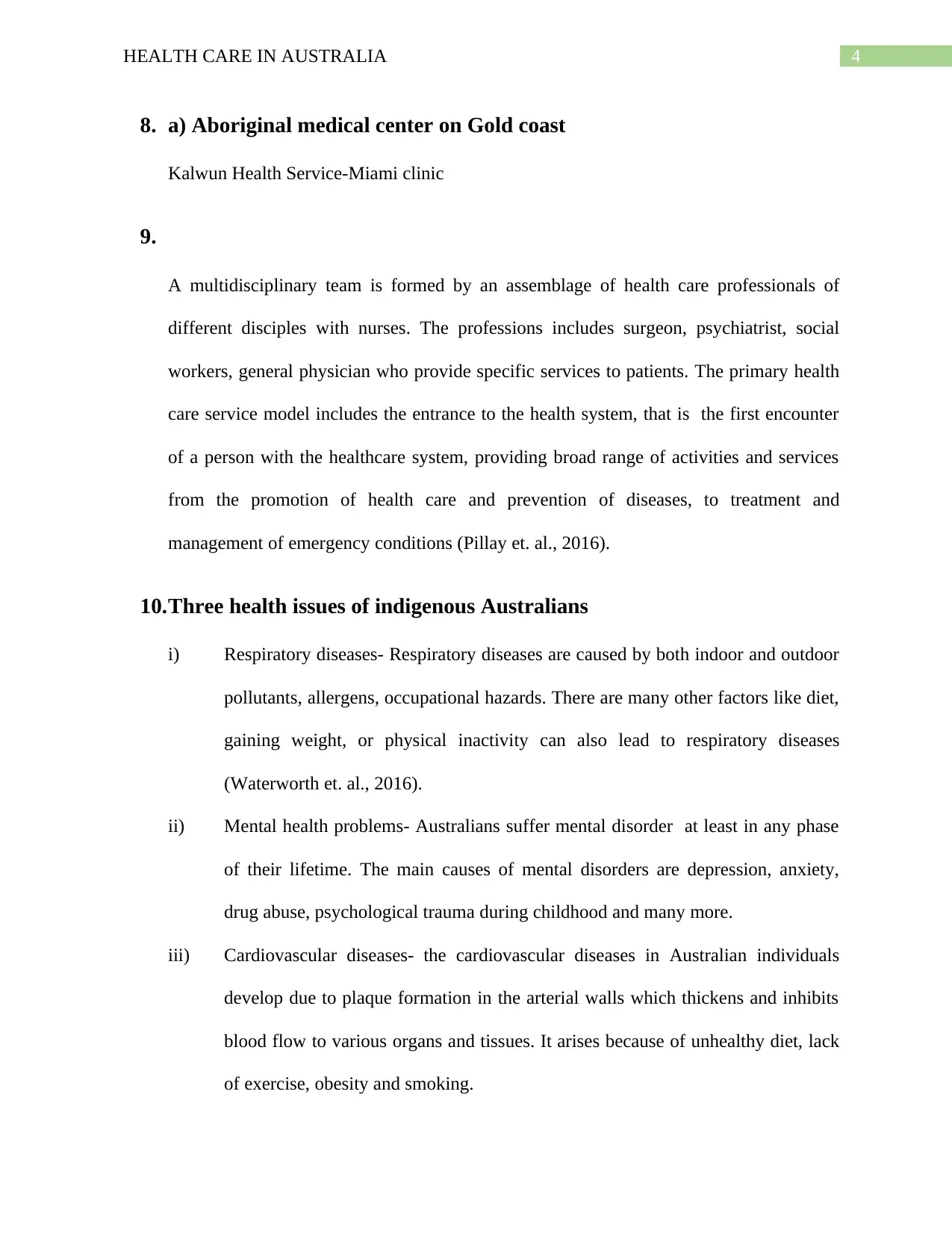
4HEALTH CARE IN AUSTRALIA
8. a) Aboriginal medical center on Gold coast
Kalwun Health Service-Miami clinic
9.
A multidisciplinary team is formed by an assemblage of health care professionals of
different disciples with nurses. The professions includes surgeon, psychiatrist, social
workers, general physician who provide specific services to patients. The primary health
care service model includes the entrance to the health system, that is the first encounter
of a person with the healthcare system, providing broad range of activities and services
from the promotion of health care and prevention of diseases, to treatment and
management of emergency conditions (Pillay et. al., 2016).
10.Three health issues of indigenous Australians
i) Respiratory diseases- Respiratory diseases are caused by both indoor and outdoor
pollutants, allergens, occupational hazards. There are many other factors like diet,
gaining weight, or physical inactivity can also lead to respiratory diseases
(Waterworth et. al., 2016).
ii) Mental health problems- Australians suffer mental disorder at least in any phase
of their lifetime. The main causes of mental disorders are depression, anxiety,
drug abuse, psychological trauma during childhood and many more.
iii) Cardiovascular diseases- the cardiovascular diseases in Australian individuals
develop due to plaque formation in the arterial walls which thickens and inhibits
blood flow to various organs and tissues. It arises because of unhealthy diet, lack
of exercise, obesity and smoking.
8. a) Aboriginal medical center on Gold coast
Kalwun Health Service-Miami clinic
9.
A multidisciplinary team is formed by an assemblage of health care professionals of
different disciples with nurses. The professions includes surgeon, psychiatrist, social
workers, general physician who provide specific services to patients. The primary health
care service model includes the entrance to the health system, that is the first encounter
of a person with the healthcare system, providing broad range of activities and services
from the promotion of health care and prevention of diseases, to treatment and
management of emergency conditions (Pillay et. al., 2016).
10.Three health issues of indigenous Australians
i) Respiratory diseases- Respiratory diseases are caused by both indoor and outdoor
pollutants, allergens, occupational hazards. There are many other factors like diet,
gaining weight, or physical inactivity can also lead to respiratory diseases
(Waterworth et. al., 2016).
ii) Mental health problems- Australians suffer mental disorder at least in any phase
of their lifetime. The main causes of mental disorders are depression, anxiety,
drug abuse, psychological trauma during childhood and many more.
iii) Cardiovascular diseases- the cardiovascular diseases in Australian individuals
develop due to plaque formation in the arterial walls which thickens and inhibits
blood flow to various organs and tissues. It arises because of unhealthy diet, lack
of exercise, obesity and smoking.
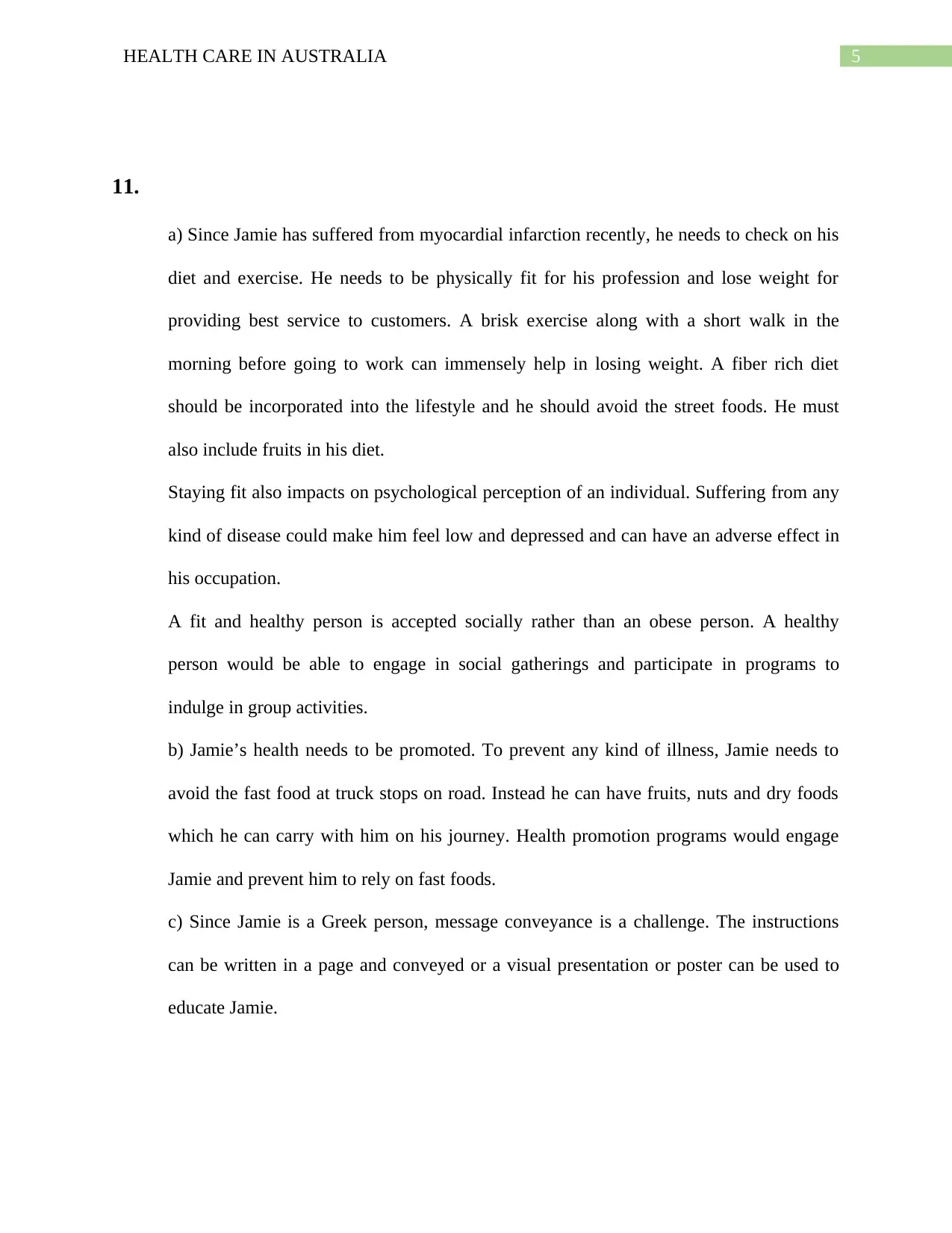
5HEALTH CARE IN AUSTRALIA
11.
a) Since Jamie has suffered from myocardial infarction recently, he needs to check on his
diet and exercise. He needs to be physically fit for his profession and lose weight for
providing best service to customers. A brisk exercise along with a short walk in the
morning before going to work can immensely help in losing weight. A fiber rich diet
should be incorporated into the lifestyle and he should avoid the street foods. He must
also include fruits in his diet.
Staying fit also impacts on psychological perception of an individual. Suffering from any
kind of disease could make him feel low and depressed and can have an adverse effect in
his occupation.
A fit and healthy person is accepted socially rather than an obese person. A healthy
person would be able to engage in social gatherings and participate in programs to
indulge in group activities.
b) Jamie’s health needs to be promoted. To prevent any kind of illness, Jamie needs to
avoid the fast food at truck stops on road. Instead he can have fruits, nuts and dry foods
which he can carry with him on his journey. Health promotion programs would engage
Jamie and prevent him to rely on fast foods.
c) Since Jamie is a Greek person, message conveyance is a challenge. The instructions
can be written in a page and conveyed or a visual presentation or poster can be used to
educate Jamie.
11.
a) Since Jamie has suffered from myocardial infarction recently, he needs to check on his
diet and exercise. He needs to be physically fit for his profession and lose weight for
providing best service to customers. A brisk exercise along with a short walk in the
morning before going to work can immensely help in losing weight. A fiber rich diet
should be incorporated into the lifestyle and he should avoid the street foods. He must
also include fruits in his diet.
Staying fit also impacts on psychological perception of an individual. Suffering from any
kind of disease could make him feel low and depressed and can have an adverse effect in
his occupation.
A fit and healthy person is accepted socially rather than an obese person. A healthy
person would be able to engage in social gatherings and participate in programs to
indulge in group activities.
b) Jamie’s health needs to be promoted. To prevent any kind of illness, Jamie needs to
avoid the fast food at truck stops on road. Instead he can have fruits, nuts and dry foods
which he can carry with him on his journey. Health promotion programs would engage
Jamie and prevent him to rely on fast foods.
c) Since Jamie is a Greek person, message conveyance is a challenge. The instructions
can be written in a page and conveyed or a visual presentation or poster can be used to
educate Jamie.
⊘ This is a preview!⊘
Do you want full access?
Subscribe today to unlock all pages.

Trusted by 1+ million students worldwide
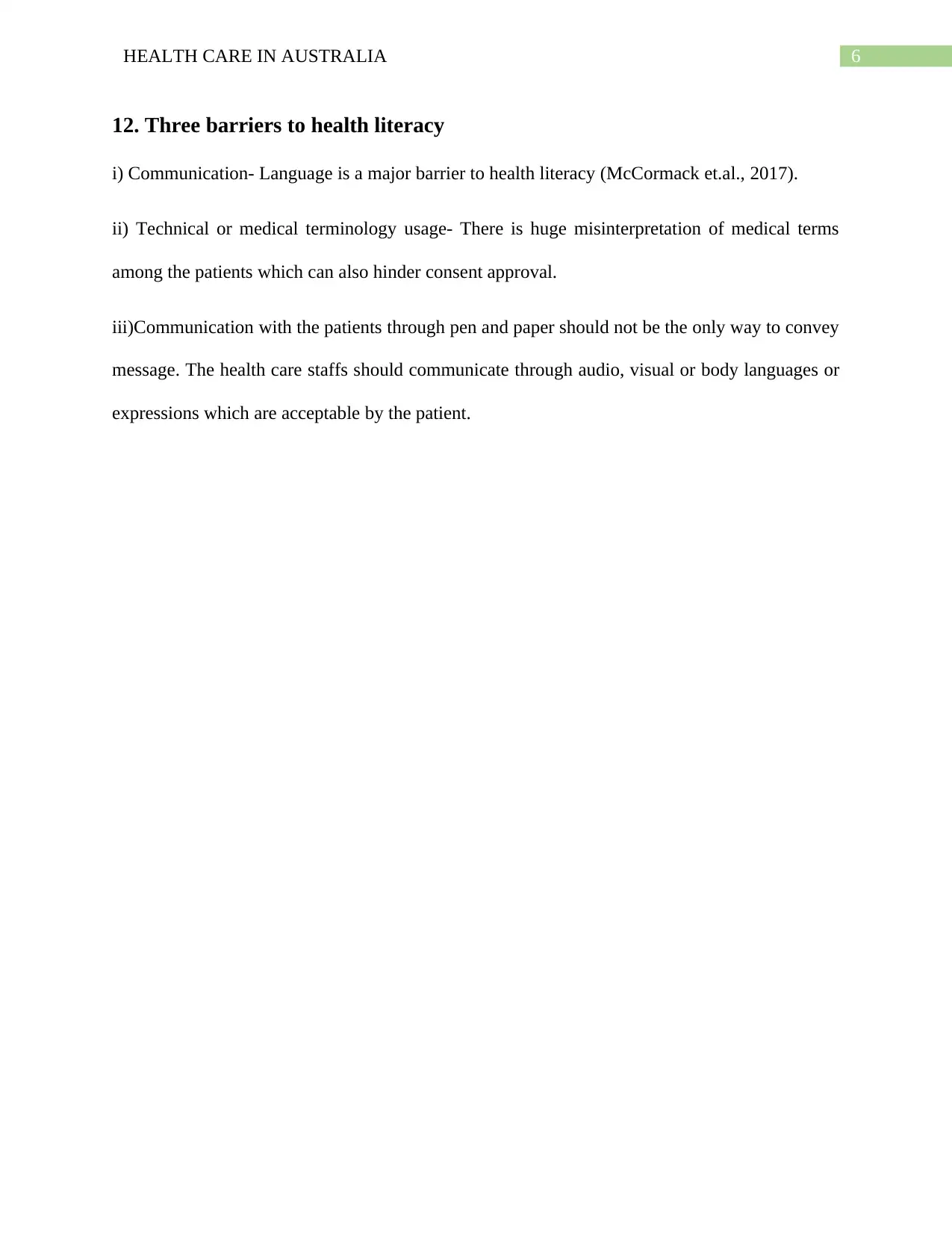
6HEALTH CARE IN AUSTRALIA
12. Three barriers to health literacy
i) Communication- Language is a major barrier to health literacy (McCormack et.al., 2017).
ii) Technical or medical terminology usage- There is huge misinterpretation of medical terms
among the patients which can also hinder consent approval.
iii)Communication with the patients through pen and paper should not be the only way to convey
message. The health care staffs should communicate through audio, visual or body languages or
expressions which are acceptable by the patient.
12. Three barriers to health literacy
i) Communication- Language is a major barrier to health literacy (McCormack et.al., 2017).
ii) Technical or medical terminology usage- There is huge misinterpretation of medical terms
among the patients which can also hinder consent approval.
iii)Communication with the patients through pen and paper should not be the only way to convey
message. The health care staffs should communicate through audio, visual or body languages or
expressions which are acceptable by the patient.
Paraphrase This Document
Need a fresh take? Get an instant paraphrase of this document with our AI Paraphraser
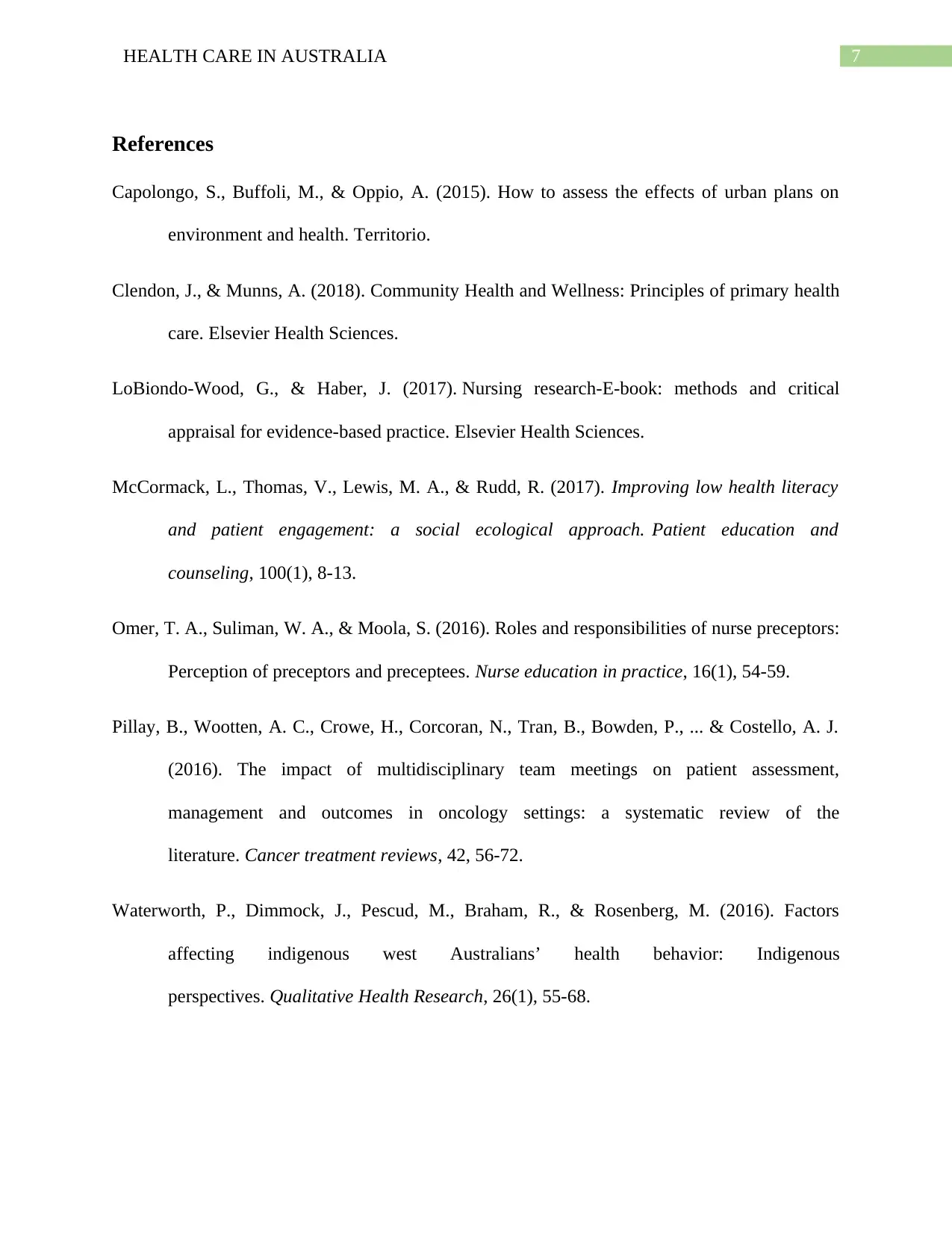
7HEALTH CARE IN AUSTRALIA
References
Capolongo, S., Buffoli, M., & Oppio, A. (2015). How to assess the effects of urban plans on
environment and health. Territorio.
Clendon, J., & Munns, A. (2018). Community Health and Wellness: Principles of primary health
care. Elsevier Health Sciences.
LoBiondo-Wood, G., & Haber, J. (2017). Nursing research-E-book: methods and critical
appraisal for evidence-based practice. Elsevier Health Sciences.
McCormack, L., Thomas, V., Lewis, M. A., & Rudd, R. (2017). Improving low health literacy
and patient engagement: a social ecological approach. Patient education and
counseling, 100(1), 8-13.
Omer, T. A., Suliman, W. A., & Moola, S. (2016). Roles and responsibilities of nurse preceptors:
Perception of preceptors and preceptees. Nurse education in practice, 16(1), 54-59.
Pillay, B., Wootten, A. C., Crowe, H., Corcoran, N., Tran, B., Bowden, P., ... & Costello, A. J.
(2016). The impact of multidisciplinary team meetings on patient assessment,
management and outcomes in oncology settings: a systematic review of the
literature. Cancer treatment reviews, 42, 56-72.
Waterworth, P., Dimmock, J., Pescud, M., Braham, R., & Rosenberg, M. (2016). Factors
affecting indigenous west Australians’ health behavior: Indigenous
perspectives. Qualitative Health Research, 26(1), 55-68.
References
Capolongo, S., Buffoli, M., & Oppio, A. (2015). How to assess the effects of urban plans on
environment and health. Territorio.
Clendon, J., & Munns, A. (2018). Community Health and Wellness: Principles of primary health
care. Elsevier Health Sciences.
LoBiondo-Wood, G., & Haber, J. (2017). Nursing research-E-book: methods and critical
appraisal for evidence-based practice. Elsevier Health Sciences.
McCormack, L., Thomas, V., Lewis, M. A., & Rudd, R. (2017). Improving low health literacy
and patient engagement: a social ecological approach. Patient education and
counseling, 100(1), 8-13.
Omer, T. A., Suliman, W. A., & Moola, S. (2016). Roles and responsibilities of nurse preceptors:
Perception of preceptors and preceptees. Nurse education in practice, 16(1), 54-59.
Pillay, B., Wootten, A. C., Crowe, H., Corcoran, N., Tran, B., Bowden, P., ... & Costello, A. J.
(2016). The impact of multidisciplinary team meetings on patient assessment,
management and outcomes in oncology settings: a systematic review of the
literature. Cancer treatment reviews, 42, 56-72.
Waterworth, P., Dimmock, J., Pescud, M., Braham, R., & Rosenberg, M. (2016). Factors
affecting indigenous west Australians’ health behavior: Indigenous
perspectives. Qualitative Health Research, 26(1), 55-68.
1 out of 8
Related Documents
Your All-in-One AI-Powered Toolkit for Academic Success.
+13062052269
info@desklib.com
Available 24*7 on WhatsApp / Email
![[object Object]](/_next/static/media/star-bottom.7253800d.svg)
Unlock your academic potential
Copyright © 2020–2025 A2Z Services. All Rights Reserved. Developed and managed by ZUCOL.





